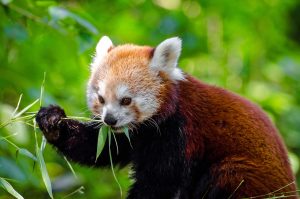Red Panda
- Scientific name : Ailurus fulgens
- IUCN Status : Endangered
- The red panda also known as the lesser panda, is a small mammal native to the eastern Himalayas and southwestern China.

- The red panda has a relatively small head, though proportionally larger than in similarly sized raccoons, with a reduced snout and triangular ears, and nearly evenly lengthed limbs.
- It has dense reddish-brown fur with a black belly and legs, white-lined ears, a mostly white muzzle and a ringed tail.
- Its head-to-body length is 51–63.5 cm (20.1–25.0 in) with a 28–48.5 cm (11.0–19.1 in) tail, and it weighs between 3.2 and 15 kg (7.1 and 33.1 lb).
- It is well adapted to climbing due to its flexible joints and curved semi-retractile claws.
- The red panda was first formally described in 1825. The two currently recognised subspecies, the Himalayan and the Chinese red panda.
- The red panda inhabits coniferous forests as well as temperate broadleaf and mixed forests, favouring steep slopes with dense bamboo cover close to water sources. It is solitary and largely arboreal.
- The red panda is difficult to observe in the wild, and most studies on its behaviour have taken place in captivity.
- The red panda appears to be both nocturnal and crepuscular, sleeping in between periods of activity at night.
- Adult pandas are generally solitary and territorial.
- The red panda is largely herbivorous and feeds primarily on bamboo, mainly the genera Phyllostachys, Sinarundinaria, Thamnocalamus and Chimonobambusa.
- It also feeds on fruits, blossoms, acorns, eggs, birds and small mammals.
- The red panda’s lifespan in captivity reaches 14 years.
- They have been recorded falling prey to leopards in the wild.
- The red panda is primarily threatened by the destruction and fragmentation of its habitat, the causes of which include increasing human population, deforestation, the unlawful taking of non-wood forest material and disturbances by herders and livestock.
